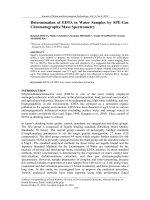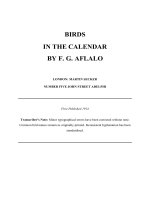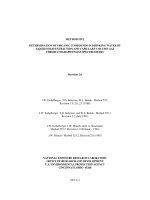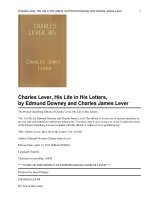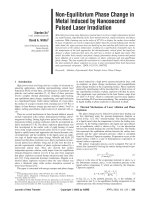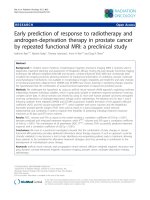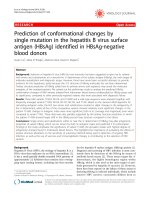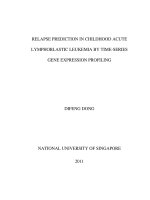Improving retention-time prediction in supercritical-fluid chromatography by multivariate modelling
Bạn đang xem bản rút gọn của tài liệu. Xem và tải ngay bản đầy đủ của tài liệu tại đây (1.33 MB, 9 trang )
Journal of Chromatography A 1668 (2022) 462909
Contents lists available at ScienceDirect
Journal of Chromatography A
journal homepage: www.elsevier.com/locate/chroma
Improving retention-time prediction in supercritical-fluid
chromatography by multivariate modelling
Stef R.A. Molenaar a,b,1,∗, Mariyana V. Savova a,b,c,1,∗, Rebecca Cross d, Paul D. Ferguson e,
Peter J. Schoenmakers a,b, Bob W.J. Pirok a,b
a
Van’t Hoff Institute for Molecular Sciences, Analytical Chemistry Group, University of Amsterdam, Science Park 904, Amsterdam 1098 XH, the Netherlands
Centre for Analytical Sciences Amsterdam (CASA), the Netherlands
TI-COAST, Science Park 904, Amsterdam 1098 XH, the Netherlands
d
Chemical Development, Pharmaceutical Technology & Development, Operations, AstraZeneca, Macclesfield, United Kingdom
e
New Modalities Product Development, Pharmaceutical Technology & Development, Operations, AstraZeneca, Macclesfield, United Kingdom
b
c
a r t i c l e
i n f o
Article history:
Received 29 September 2021
Revised 4 February 2022
Accepted 15 February 2022
Available online 17 February 2022
Keywords:
SFC
Retention modelling
Multivariate
Mass fraction
Pressure
a b s t r a c t
The prediction of chromatographic retention under supercritical-fluid chromatography (SFC) conditions
was studied, using established and novel theoretical models over ranges of modifier content, pressure and
temperature. Whereas retention models used for liquid chromatography often only consider the modifier
fraction, retention in SFC depends much more strongly on pressure and temperature. The viability of
combining several retention models into surfaces that describe the effects of both modifier fraction and
pressure was investigated. The ability of commonly used retention models to describe retention as a
function of modifier fraction, expressed either as mass or volume fraction, pressure and density was
assessed. Using the multivariate surfaces, retention-time prediction for isocratic separations at constant
temperature improved significantly compared to univariate modelling when both pressure and modifier
fractions were changed. The “mixed-mode” model with an additional exponential pressure or density
parameter was able to predict retention times within 5%, with the majority of the predictions within 2%.
The use of mass fraction and density further improves retention modelling compared to volume fraction
and pressure. These variables however, do require extra computations.
© 2022 The Author(s). Published by Elsevier B.V.
This is an open access article under the CC BY license ( />
1. Introduction
In the last decade, the interest in supercritical- and subcriticalfluid chromatography (SFC) has increased considerably following the hardware innovations that have taken place [1–4]. These
improvements ultimately allowed modern ultra-high-performance
SFC instruments to rival the robustness of ultra-high-performance
liquid-chromatography (UHPLC) systems on the market [5]. Concurrently, today’s practice of employing modified mobile phases
with or without additives greatly expanded the polarity range of
compounds compatible with SFC. This has enabled the use of SFC
∗
Corresponding authors at: Van’t Hoff Institute for Molecular Sciences, Analytical
Chemistry Group, University of Amsterdam, Science Park 904, Amsterdam 1098 XH,
the Netherlands.
E-mail addresses: (S.R.A. Molenaar),
(M.V. Savova).
1
These authors contributed equally.
in a diverse range of areas including natural products [6], pharmaceutical [4], food [7], forensics [8] and bio-analysis [9].
Despite the resurgence of SFC in analytical laboratories, the fact
that the technique has received little attention for two decades has
slowed down progress in fundamental understanding [10]. Most
fundamental literature focuses on neat-carbon dioxide (neat-CO2 )
separations, which are rarely performed today. In contrast, contemporary research aims at broadening the applicability of SFC. Consequently, the applicability of retention modelling has remained relatively unexplored.
The field of retention modelling in chromatography has five
fundamentally different main application areas, as recently reviewed by Den Uijl et al. [11]. Applications such as stationaryphase characterization, understanding retention and lipophilicity
determination are of great interest within the field of chromatography. These applications however, make use of more complicated
retention models such as the linear solvation energy relationship
(LSER) or quantitative structure retention relationships (QSRR).
Where contributions from, but not limited to, acidity/basicity, mo-
/>0021-9673/© 2022 The Author(s). Published by Elsevier B.V. This is an open access article under the CC BY license ( />
S.R.A. Molenaar, M.V. Savova, R. Cross et al.
Journal of Chromatography A 1668 (2022) 462909
lar refraction and polarity can be determined by LSER [12–14] and
retention for compounds can be predicted when the analyte structure is known by QSRR [15,16]. To determine and use these models however, a large amount of input is necessary for the analyte,
stationary- and mobile-phase chemistry. In the application fields
of method transfer and, in the scope of this work, method optimization, typically less complicated retention models are used to
find an empirical relationship between retention time and modifier fractions. These retention models describe the retention in
pure weak solvent and the change in retention due to the strong
solvent. These parameters differ for different analytes, columns
and mobile-phases. However it was shown that retention within
the same chromatographic mode follow the same retention model
[11,17–20].
A benefit of these simpler empirical models, is that the relationship can often be determined using a limited number of
scouting runs (e.g. two to six depending on the retention model
used). The development of measurement based retention models
can be used for the development of in-silico method optimization
approaches such as those already available for one-dimensional
[21,22], two-dimensional [23] and even three-dimensional [24] liquid chromatography (LC). The development of such tools for SFC is
complicated by the compressibility of sub- and supercritical fluids in comparison to liquids. Due to this increased compressibility,
many parameters that arguably can be considered constant in LC
are not in SFC [25], such as the mobile-phase density, which is a
function of pressure and temperature [26,27].
Recently, Tyteca et al. [28] explored the possibilities of retention modelling in SFC, using non-linear models for the natural logarithm of the retention factor (ln k) as a function of the volume
fraction of modifier (ϕ ), namely the quadratic [29], mixed-mode
[30] and Neue-Kuss [31,32] models. Aiming at optimizing gradient
methods, the authors evaluated the possibility of gradient prediction using models built using isocratic, as well as gradient data
[28]. The authors found that utilizing isocratic retention data for
gradient prediction was complicated by pressure effects. In this
case prediction errors generally were within 10%, irrespective of
the conditions of the predicted gradient. Models generated with
gradient data were more accurate, (prediction errors within 5%)
when the starting conditions of the scouting and predicted gradient runs were equal, but were poorer when this was not the case
(errors up to 46%). Possible explanations for the reduced accuracy
in the latter case were not provided by the authors, but their findings are in agreement with documented issues when constructing
retention models using gradient data [33] and the need to consider gradient deformation [34,35]. The authors did not evaluate
the incorporation of a pressure or density term within the retention models [28]. Neither was this the case for other studies in the
field [36–38].
With pressure impacting retention [39], incorporating the
mobile-phase density in the retention models may increase prediction accuracy. The recent versions of the Reference Fluid Thermodynamic and Transport Properties Database (REFPROP) of NIST
[40] include CO2 -methanol systems, enabling chromatographers to
explore the effect of density in such systems [26].
In this study we aimed to explore the feasibility of modelling
retention of isocratic SFC separations, considering the modifier
fraction as well as the pressure and density. The retention models evaluated include exponential [41], adsorption [20], quadratic
[29], mixed-mode [30] and Neue-Kuss [31,32] models, with an additional term describing either pressure or density. Due to the
mobile-phase compressibility, the modelling was performed using
mass fractions instead of volume fractions, as proposed by de Pauw
et al. [39] The goodness-of-fit and the ability to predict retention
under different experimental conditions were assessed for each
model. The performance of the models was compared with and
without a pressure or density term for nine model analytes with
diverse physicochemical properties (e.g. acids, bases, neutrals). The
ultimate aim of our work is to develop empirical multivariate retention models that can be used in method-optimization software
in situations in which both the effects of modifier concentration
and pressure need to be considered.
2. Experimental
2.1. Chemicals
Methanol (MeOH - UPLC/MS grade) was purchased from
Biosolve (Valkenswaard, The Netherlands). Ammonium acetate
(reagent grade, ≥ 98%), naproxen, salicylic acid, acetaminophen,
bisphenol A, hydrochlorothiazide, 4-aminoantipyrine, propranolol
hydrochloride, and trimethoprim were obtained from SigmaAldrich (Darmstadt, Germany). Tacrine hydrochloride was obtained
from the United States Pharmacopeia (North Bethesda, MD, USA).
SFC-grade carbon dioxide (grade 4.8) was obtained from Praxair
(Vlaardingen, The Netherlands). Water used during the experiment
(18.2 mΩ) was obtained from a Milli-Q purification system (Millipore, Bedford, MA, USA).
2.2. Sample preparation
Stock solutions of each analyte were prepared in methanol at a
concentration of 100 mg·mL−1 , except for the hydrochlorothiazide
and trimethoprim stock solutions, which were prepared at a concentration of 10 mg·mL−1 . The compounds that did not readily
dissolve in MeOH were ultrasonicated until completely dissolved.
Standards were stored at 4 °C.
2.3. Chromatographic system
Experiments were conducted on a Waters Acquity UPC2 system (Waters, Etten-Leur, The Netherlands) equipped with a binary
solvent-delivery pump (maximum allowed flow rate and pressure
of 4 mL·min−1 and 413 bar, respectively), an autosampler equipped
with a 10 μL loop, a column oven, a photodiode-array (PDA) detector fitted with an 8 μL flow-cell, and a two-step (active and passive) backpressure regulator (BPR). The passive component of the
BPR kept the pressure at 104.3 bar, whereas the active component
adjusted the final pressure until the desired value was reached. The
data-acquisition rate of the PDA detector was set at 25 Hz. The
chromatograms were recorded using Empower3 software (Waters).
2.4. Chromatographic conditions
A Waters Viridis BEH column (100 × 3 mm i.d., d p = 3.5 μm)
was used in the study. The mobile phase consisted of CO2 modified with methanol. The latter solvent contained 2% (v/v) water
and ammonium acetate (20 mM) as additives. This additive was
shown by Lemasson et al. [42] to provide good peaks shapes for a
range of analytes of different physico-chemical properties. The additive was prepared as a 1 M solution in MilliQ water, and then
diluted to 20 mM in MeOH. All measurements were carried out in
isocratic mode with a fixed volumetric flow rate of 1.5 mL·min−1 .
Retention was studied by varying the modifier fraction between 2
and 36% (v/v) depending on the analyte studied, to ensure that the
analytes were retained on the column (i.e. retention factor (k) ≥
1) and eluted in a reasonable time period (within approximately
30 min). These retention factors were chosen to ensure data was
available for modelling, if the analyte does not interact with the
column (i.e. no retention), no meaningful conclusions about the retention model can be made. The analyses were performed at three
2
S.R.A. Molenaar, M.V. Savova, R. Cross et al.
Journal of Chromatography A 1668 (2022) 462909
backpressure levels of 120, 160 and 200 bar, and two temperatures
of 25 and 40 °C.
The autosampler was set at 25 °C. The analytes were dissolved
in pure methanol and injected in mixtures, consisting of compounds that were not expected to coelute nor to interact (e.g.
acidic and basic analytes were not used in the same mixture).
The final analyte concentration was 5.0 mg·mL−1 except for hydrochlorothiazide and trimethoprim (4.7 mg·mL−1 ) and tacrine
(6.7 mg·mL−1 ). “Partial loop with needle overfill” (PLNO) injection
was performed of 0.1 μL volumes using a 10 μL loop, carried out
under the default settings of the instrument. ACN was used as
needle-wash solvent (500 μL). PDA spectra were recorded across
the range of 190 to 360 nm, with 210 nm as reference, and a resolution of 1.2 nm. The UV spectra were used to confirm identification of the individual components.
system dead time. In SFC, the dead time may change significantly
with CO2 -MeOH mixtures as a function of pressure, temperature,
and mobile-phase composition. In order to account for this variation, the dead time for each individual setting was estimated as
follows, unless stated otherwise: (1) the column volume was calculated using the first baseline disturbance of the solvent peak as
a marker for the dead time under reference conditions (36% (v/v)
of modifier, 25 °C, back-pressure of 200 bar), at which the compressibility of the mobile phase was lowest amongst all the studied settings; (2) the actual volumetric flow rate was calculated by
first determining the total mass flow rate (MFtotal ) under experimental conditions. This was calculated using the set volumetric
flow rate and Eq. (3); (3) using MFtotal and the determined mobilephase density, the actual volumetric flow rate was calculated; (4)
the dead time was then calculated using the actual volumetric flow
rate and the column volume estimated in step 1.
2.5. Software
MFtotal = Fv (ϕ
(3)
Such an complex determination of t0 was undertaken, since
the shape of the solvent peak was inconsistent throughout the
measurements, under different experimental conditions as well as
for replicate measurements, making conventional estimation of t0
prone to visual error [44].
3. Theory
3.1. Mass fraction and density calculations
3.3. Retention modelling
For the density calculations, the pressures at the both the pump
and the active BPR were recorded throughout the analysis. The
pressures recorded at the pump and at the active BPR were assumed to be equal to those at the column inlet and outlet, respectively. The mean column pressure was approximated as the mean
of these two pressures. The set column temperature was assumed
to equal the fluid’s temperature throughout the column for this
project.
The calculations of the mobile-phase density were carried out
using the REFPROP version 10 software curated by NIST [40].
As the density of ternary mixtures containing carbon dioxide,
methanol and water cannot be calculated using this software, the
modifier was assumed to be pure methanol. This is a reasonable
assumption because the modifier used in this study contained only
2% (v/v) of 1 M aqueous ammonium-acetate solution. The density
calculations were based on the mixing rules of Kunz et al. [43] using the pressure, temperature and mass fraction (χ ) of methanol
as input values. Due to the compressibility of CO2, χ varies not
only with the set volume fraction of modifier, but also with the
pumping pressure (Ppump ). The formula used to calculate χ under
different conditions in shown in Eq. (1).
χ=
ρMeOH [Tlab , Ppump (Fv , ϕ )]
+ (1 − ϕ )ρCO2 [TCO2 , Ppump (Fv , ϕ )] )
Retention modelling was performed with an in-house script using the lsqcurvefit function within Matlab-software R2020a (Mathworks, Natick, MA, USA).
When utilizing modifiers under sub-critical conditions, contemporary SFC methods often resemble LC. For this reason, the retention models evaluated in this study were based on empirical retention models commonly used in LC [11]. The exponential model
describes partitioning in RPLC separations [41] (Eq. (4)).
ln k = ln k0 − Sϕ
(4)
Here, ϕ is the volume fraction of modifier, k0 is the extrapolated retention factor for ϕ = 0, and S is the so-called solventstrength parameter, relating to the strength of the strong solvent
(typically 3–5 for small molecules in RPLC). For a broader range
of mobile-phase compositions, the relationship between ln k and ϕ
is concave, thus the use of a quadratic model (Eq. (5)) has been
proposed [29], which is given by
ln k = ln k0 + S1 ϕ + S2 ϕ 2
(5)
Where S1 and S2 are the coefficients that describe the retention
under the influence of the modifier. The adsorption model (Eq. (6))
is typically used for normal-phase separations [20], but has been
shown to be robust when using a limited number of input variables in other mixed-mode retention mechanisms, such as HILIC
[17].
ϕ ρMeOH [Tlab , Ppump (Fv , ϕ )]
ϕ ρMeOH [Tlab , Ppump (Fv , ϕ )] + (1 − ϕ )ρCO2 [TCO2 , Ppump (Fv , ϕ )]
ln k = ln k0 − n ln ϕ
(1)
(6)
in which Fv is the set volumetric flow rate, ϕ the volume fraction
of modifier, Tlab the temperature in the laboratory, assumed to be
constant (23 °C) and TCO2 the set accumulator CO2 pump temperature (13 °C), while ρMeOH and ρCO2 are the densities of MeOH and
CO2 , calculated using REFPROP software [40].
Here, n is the ratio between the molecular area of adsorbed solute (As ) and the number of strong solvent molecules needed to
desorb the analyte molecules (nB ).
The mixed-mode model, shown in Eq. (7), is a combination of
the partitioning and adsorption models. It has also been used to
describe HILIC retention [30].
3.2. Retention factor and column dead time determination
ln k = ln k0 + S1 ϕ + S2 ln ϕ
The retention factor k for isocratic elution was calculated using
Eq. (2).
k=
tR − t0
t0
(7)
One disadvantage of the quadratic and mixed-mode models is
that they have no exact integral that allows calculation of retention
times under gradient conditions. The Neue-Kuss model (Eq. (8)),
which is an empirical model developed to aid integration under
gradient conditions, elegantly solves this issue [32].
(2)
Where tR is the retention time of the analyte, determined using
the peak apex – even if the peak was asymmetrical, and t0 is the
ln k = ln k0 + 2 ln (1 + S2 ϕ ) −
3
S1 ϕ
1 + S2 ϕ
(8)
S.R.A. Molenaar, M.V. Savova, R. Cross et al.
Journal of Chromatography A 1668 (2022) 462909
Fig. 1. Boxplots of AIC values for each model. AIC scores for the different pressures
are binned together. From left to right; exponential (Exp, blue, Eq. (4)), adsorption
(Ads, yellow, Eq. (6)), mixed-mode (Mix, green, Eq. (7)), quadratic (Quad, purple,
Eq. (5)) and Neue-Kuss (NK, red, Eq. (8)) at 25 °C (left group) and 40 °C (right
group). (For interpretation of the references to color in this figure legend, the reader
is referred to the web version of this article.)
Fig. 3. Boxplot of prediction errors for each model. From left to right; exponential (Exp, blue, Eq. (4)), adsorption (Ads, yellow, Eq. (6)), mixed-mode (Mix, green,
Eq. (7)), quadratic (Quad, purple, Eq. (5)) and Neue-Kuss (NK, red, Eq. (8)) at 25 °C
followed by 40 °C. (For interpretation of the references to color in this figure legend,
the reader is referred to the web version of this article.)
Due to the compressibility of CO2 -methanol mixtures, the actual value of ϕ does not coincide with the set value and varies
along the chromatographic system. Meanwhile, χ may depend on
pressure but is constant throughout the system [39,45]. The work
of de Pauw et al. published in 2016, showed that retention in SFC is
best modelled using χ instead of ϕ [39]. Accordingly, in this work
the ϕ variable in the above models was replaced by χ .
It is well-recognized that even under subcritical conditions,
pressure or density changes impact retention in SFC. For this reason, in addition to the models introduced above where the modifier effect was considered exclusively, two-variable models, including either the pressure or the density, were also studied. These
two-variable models were constructed by adding a pressure or
density term to the existing models (Eqs. (4)–(8)). See Eq. (9) for
an example.
The additional parameters were equivalent to the second parameter of the exponential and adsorption model (i.e. +Sχ and
+n ln χ ), with the only difference that instead of χ as a variable,
either pressure (P ) of density (ρ ) was used. As an example, the
addition an exponential pressure parameter to the mixed-mode
model describing the effect of modifier entails adding an S3 P term
(with S3 as a model coefficient) to the mixed-mode model (Eq. (7)),
resulting in
For a list of all retention equations used, please refer to Supplementary Material Section S-1.
ln k = ln k0 + S1 χ + S2 ln χ + S3 P
F=
3.4. Goodness of fit and retention-time predictions
The goodness-of-fit of the models was determined using the
Akaike information criterion (AIC), which takes into consideration
the number of parameters used to build the model and, therefore,
allows for a fair comparison between models containing different
numbers of parameters. The AIC is calculated according to [46]
AIC = 2 pm + nD ln
2π SSQ
nD
+1
(10)
where pm is the number of parameters in the model, nD is the
number of datapoints and SSQ is the sum of squared errors between the fit and the datapoints.
In order to compare models differing by the addition of a single
term, such as the exponential and mixed-mode models, the statistical F-test of regression [47,48] was used with α = 0.05. This
test compares two models taking into consideration the residual
sum-of-squares of the full model SSres,full with that of the reduced
model SSres,red , as show in Eq. (11).
(9)
MSres,diff
=
MSres,full
SSres,full − SSres,red /(νred − νfull )
SSres,full /νfull
(11)
Fig. 2. Retention plots of (A) naproxen, (B) hydrochlorothiazide and (C) tacrine fitted with the mixed-mode model for each different set of pressure and temperature values.
4
S.R.A. Molenaar, M.V. Savova, R. Cross et al.
Journal of Chromatography A 1668 (2022) 462909
MSres,diff and MSres,full are the difference between the residual
mean-squares errors of the reduced and full model, and the residual mean-squares error of the full model respectively, while νred
and νfull are the respective degrees of freedom of the reduced and
full model. For example, the exponential model (Eq. (4)) can be the
reduced model, while the mixed-mode model (Eq. (7)) is the full
model. The prediction error of the models was assessed according
Eq. (12).
Error (% ) =
tR,pred − tR,exp
· 100%
tR,exp
between 2.5 and 70 and all models were fitted to these data. For
all data regarding the experimental retention times, modifier fractions and model parameters, please refer to Supplementary Material Section S-2. The goodness-of-fit of each model was expressed
through computation of the AIC Fig. 1. shows the spread of the AIC
values for each model. The AIC value is based on the logarithm of
the sum of squared errors. Therefore, the smaller or more negative the value, the better the model describes the data. The results
suggest that the mixed-mode model best describes the data, followed by the adsorption model. In contrast, the exponential model
appeared not to describe the data accurately.
To assess the statistical significance of the third parameter in
the mixed-mode model compared to the adsorption model, an Ftest was performed following Eq. (11). For six out of nine compounds, the addition of the additional term (third parameter) was
significant for all six different combinations of backpressures and
temperatures, while for the other three compounds the addition
was significant for at least three of the combinations.
Fig. 2 shows the retention factors for three analytes, namely
naproxen (acidic), hydrochlorothiazide (neutral) and tacrine (basic)
with the mixed-mode model fitted to the data. As can be seen, the
mixed-mode model describes these data well. However, the curves
for each different combination temperature and backpressure do
not overlap, indicating that pressure and temperature have a significant effect on retention.
Besides a comparison of AIC scores, the ability to predict retention times for other mass fractions was investigated. Given that
pressure and temperature have an effect on retention, as shown
in Fig. 2, predictions were exclusively assessed for the same pressure and temperature. For each analyte, four different mass fractions and corresponding retention times were selected per combination of pressure and temperature and retention models were
fitted to these data points. The retention times for the remaining
mass fractions were then predicted and compared with the experimental data. The resulting prediction errors are shown in Fig. 3.
For a table of datapoints used for each model and the predictions,
please refer to Supplementary Material Section S-2. Similar to the
AIC values, the mixed-mode model performed best, followed by
the adsorption model. The exponential model appeared unable to
accurately describe the data and was therefore left out of further
modelling studies.
(12)
In which tR,pred and tR,exp are the predicted and experimentally
observed retention times at the peak maximum, respectively.
For computing the prediction error, two replicates were used
for each point (χ ,ρ ) to construct the model, whereas for computation of AIC values up to three replicate measurements were considered. For the latter calculations measurements were performed
with 5 and 15% (v/v) of MeOH at 120, 160 and 200 bar.
4. Results & discussion
For MeOH/CO2 systems the modifier concentration and, to a
lesser extent in the practical working range, the density (and thus
physical parameters, namely pressure and temperature) govern retention [49]. Therefore, accurate retention modelling in SFC requires that the effects of both the modifier concentration and the
density be considered. These effects were modelled for nine compounds varying in physicochemical properties (e.g. acidic, basic and
neutral compounds). Prior to modelling both effects simultaneously, the effect of modifier fraction was considered alone.
4.1. Modelling the effect of modifier
The effect of modifier was assessed at three different backpressures (120, 160 and 200 bar) and two different temperatures
(25 and 40 °C). These different conditions were chosen to assess the broader applicability of the retention models. As stated in
Section 3.1, the modelling was performed against the mass fraction
of modifier (χ ), rather than the volume fraction (ϕ ). For each different combination of pressure and temperature the modifier fraction was varied in such a way that the retention factors ranged
Fig. 4. (A) Changes in modifier mass-fraction with different pressures for a volume fraction of 0.05. Red diamond represent data points for a temperature of 25 °C, green
circles represent data for a temperature of 40 °C. (B) Changes in modifier mass-fraction with different pressures for a volume fraction of 0.15. Red diamond represent data
points for a temperature of 25 °C, green circles represent data for a temperature of 40 °C. (C) Changes in mobile phase density when the pressure changes for ϕ = 0.05,
25 °C (Red diamonds), ϕ = 0.15, 25 °C (Green circles), ϕ = 0.05, 40 °C (Purple crosses) and ϕ = 0.15, 40 °C (Yellow squares). (For interpretation of the references to color in
this figure legend, the reader is referred to the web version of this article.)
5
S.R.A. Molenaar, M.V. Savova, R. Cross et al.
Journal of Chromatography A 1668 (2022) 462909
Fig. 5. Retention surfaces of (A) naproxen, (B) hydrochlorothiazide and (C) tacrine at 25 °C, fitted with the mixed-mode model with the addition of an exponential pressure
parameter. Datapoints used to fit the models and are represented by red circles. (For interpretation of the references to color in this figure legend, the reader is referred to
the web version of this article.)
Fig. 6. Boxplots of prediction errors of each investigated model with different added parameters for the pressure contribution. The blue lines indicate prediction errors of
±2.5%. From left to right; adsorption (Ads, yellow), mixed-mode (Mix, green), quadratic (Quad, purple) and Neue-Kuss (NK, red) models with no added parameter, followed
by the addition of an exponential parameter and adsorption parameter. (For interpretation of the references to color in this figure legend, the reader is referred to the web
version of this article.)
isolated. This is shown in Fig. 4, with the effect of pressure on the
mass fraction of the modifier and mobile-phase density plotted for
two different volume modifier fractions (ϕ = 0.05 and ϕ = 0.15)
and temperatures (25 and 40 °C).
As can be seen in Fig. 2, the retention plots of the different
pressures are not overlapping. This implies that the pressure has a
significant effect on retention. To compensate for the pressure, extra parameters within the retention models were added to describe
the variations due to pressure. Instead of creating a retention line
as in Fig. 2, a retention surface was constructed as shown in Fig. 5.
Creating the retention surface was achieved using data from different combinations of modifier concentration and pressure. For
each analyte 12 datapoints were used to construct the surface
models, and the remaining datapoints were predicted. To perform
appropriate modelling, the datapoints used to create the models
required elution of the analyte with reasonable retention factors
(2.5 < k < 70). For an exact list of datapoints used for modelling and prediction for each analyte please refer to Supplementary Material Section S-3. Fig. 6. shows the prediction errors for
each model. The results suggest that adding an extra parameter
for the pressure effect reduced the prediction errors. Statistical Ftests were performed to verify the significance of adding an extra
parameter to the models. The addition of an extra parameter was
found to be significant for all of the surface models. Furthermore,
it can be seen that the prediction errors of the mixed-mode model
(based on Eq. (7)) with added exponential pressure term, are
smallest and most closely centred around 0%. Thus, it outperforms
Fig. 7. Stacked boxplots indicating which models performed (From left to right: adsorption, mixed-mode and Neue-Kuss) best between those with extra pressure (red,
bottom) or density (green, top) parameters. The black line indicates 50%, i.e. where
the effects of adding a pressure or density term were comparable. The left group
has the addition of an exponential term, whereas the right group has the addition
of an adsorption term. (For interpretation of the references to color in this figure
legend, the reader is referred to the web version of this article.)
4.2. Modelling the combined effect of modifier and pressure
To include the effect of pressure, the actual mass fraction of modifier must be known. However, as stated in
Section 3.1 (Eq. (1)), the system pressure affects the mass fraction
of modifier and the effect of pressure can therefore not be entirely
6
S.R.A. Molenaar, M.V. Savova, R. Cross et al.
Journal of Chromatography A 1668 (2022) 462909
Fig. 8. Boxplots of prediction errors of each investigated model (indicated at the bottom). Six (6p) or eight (8p) datapoints were used. χ indicates the use of mass fractions
in the equation, whereas ϕ indicates the use of volume fractions. P and ρ indicate the addition of an exponential pressure or density parameter in the model, respectively.
The blue lines indicate prediction errors of ±2.5% and 0%. From left to right: adsorption (Ads + Exp, yellow), mixed-mode with (Mix + Exp, green), and Neue-Kuss (NK + Exp,
red). (For interpretation of the references to color in this figure legend, the reader is referred to the web version of this article.)
than ±5%, with more than half of the prediction errors between
±2%.
Considering density rather than pressure was found to further
improve accuracy of the models. However, pressure is more practical, requiring less computation, while still improving modelling
significantly compared to univariate modelling (e.g. modifier fraction only). Similarly, compared to the use of volume fraction, the
mass fraction improved the modelling accuracy. This modification
is worthwhile, despite requiring extra calculations.
Modelling was performed at two different temperatures and it
was apparent that temperature had a significant effect on retention behavior. Therefore, the effect of temperature as a third variable could be of interest. This, however, would complicate modeling further. Retention modeling is of great interest for optimization
software and predicting retention under conditions of modifier and
pressure gradients is of high relevance. Gradient predictions were
not investigated in this work. To do so, gradient equations using
partial integrals of both modifier and pressure/density must be derived and will be the focus of future investigations.
the other models. The quadratic model (based on Eq. (5)), exhibits
a large range of prediction errors, despite the addition of an extra
pressure term. It was therefore left out of further modelling.
The addition of a density parameter (i.e. exponential and adsorption) instead of a pressure parameter was also investigated using the adsorption, mixed-mode and Neue-Kuss models. Calculating the density of the mobile phase required extra computations
using the REFPROP software. Fig. 7. shows stacked boxplots indicating where replacing the pressure parameter for a density parameter yielded better results. As can be seen, the errors of only
two of the models were improved for more than 50% of the predictions, whereas for the remaining models the predictions performed
worse. However, for the model that performed best, i.e. the mixedmode model with an exponential pressure parameter (+n ln P - see
Fig. 6), the prediction errors improved for 63% of the measurements.
Lastly, the performance of the models was tested with fewer
datapoints and by varying the input parameters – mass fraction or
volume fraction, and pressure or density. Volume fractions (at the
moment of delivery, i.e. at the top of the column) do not require
extra calculations to set up the models and thus are more straightforward to use. For a detailed description of the datapoints used,
please refer to Supplementary Material Sections S-4 & S-5 Fig. 8.
shows the prediction errors of all these models. As can be seen,
prediction errors are lowest with the additional two datapoints,
when mass fraction and the extra density term are used (left-hand
side of Fig. 8). However, even when 6 points, volume fraction and
pressure are used, most of the prediction errors are still within 5%
when using the mixed-mode with an extra exponential parameter,
which may be acceptable in some cases. Such “simple” modelling
does not require extra calculations and is simpler to set up than
the 8- or 12-point models.
Declaration of Competing Interest
The authors declare that they have no known competing financial interests or personal relationships that could have appeared to
influence the work reported in this paper.
CRediT authorship contribution statement
Stef R.A. Molenaar: Conceptualization, Methodology, Software,
Validation, Writing – original draft, Visualization, Supervision.
Mariyana V. Savova: Conceptualization, Methodology, Software,
Validation, Formal analysis, Investigation, Data curation, Writing –
review & editing, Visualization. Rebecca Cross: Conceptualization,
Resources, Supervision. Paul D. Ferguson: Conceptualization, Resources, Writing – review & editing, Supervision, Project administration, Funding acquisition. Peter J. Schoenmakers: Conceptualization, Resources, Writing – review & editing, Project administration, Funding acquisition. Bob W.J. Pirok: Conceptualization, Resources, Writing – review & editing, Supervision, Project administration.
5. Conclusions
The results of this study underlined that pressure has a significant effect on the retention of analytes in SFC and thus impacts
retention modelling. Considering pressure when predicting retention as a function of modifier fraction through multivariate modelling yielded a significant improvement compared to univariate
modelling. The mixed-mode model appeared to predict retention
in SFC best, and addition of an exponential parameter for density
(ln k = ln k0 + S1 χ + S2 ln χ + S3 ρ ) yielded prediction errors lower
7
S.R.A. Molenaar, M.V. Savova, R. Cross et al.
Journal of Chromatography A 1668 (2022) 462909
Acknowledgments
[20] L.R. Snyder, H. Poppe, Mechanism of solute retention in liquid—solid chromatography and the role of the mobile phase in affecting separation: competition versus “sorption,”, J. Chromatogr. A 184 (1980) 363–413, doi:10.1016/
S0 021-9673(0 0)93872-X.
[21] L.R. Snyder, J.W. Dolan, D.C. Lommen, Drylab® computer simulation for highperformance liquid chromatographic method development. I. Isocratic elution,
J. Chromatogr. A 485 (1989) 65–89, doi:10.1016/S0021-9673(01)89133-0.
[22] J.W. Dolan, D.C. Lommen, L.R. Snyder, Drylab® computer simulation for highperformance liquid chromatographic method development. II. Gradient elution,
J. Chromatogr. 485 (1989) 91–112, doi:10.1016/S0021-9673(01)89134-2.
[23] B.W.J. Pirok, S. Pous-Torres, C. Ortiz-Bolsico, G. Vivó-Truyols, P.J. Schoenmakers, Program for the interpretive optimization of two-dimensional resolution,
J. Chromatogr. A 1450 (2016) 29–37, doi:10.1016/j.chroma.2016.04.061.
[24] R. Kormány, I. Molnár, H.J. Rieger, Exploring better column selectivity choices
in ultra-high performance liquid chromatography using quality by design principles, J. Pharm. Biomed. Anal. 80 (2013) 79–88, doi:10.1016/j.jpba.2013.02.028.
[25] T. Fornstedt, R.E. Majors, Modern supercritical fluid chromatography: possibilities and pitfalls, LC GC Eur. 28 (2015) 445–450.
[26] T.A. Berger, Effect of density on kinetic performance in supercritical fluid chromatography with methanol modified carbon dioxide, J. Chromatogr. A 1564
(2018) 188–198, doi:10.1016/j.chroma.2018.06.021.
[27] A. Tarafder, K. Kaczmarski, M. Ranger, D.P. Poe, G. Guiochon, Use of the isopycnic plots in designing operations of supercritical fluid chromatography: IV.
Pressure and density drops along columns, J. Chromatogr. A 1238 (2012) 132–
145, doi:10.1016/j.chroma.2012.03.066.
[28] E. Tyteca, V. Desfontaine, G. Desmet, D. Guillarme, Possibilities of retention
modeling and computer assisted method development in supercritical fluid
chromatography, J. Chromatogr. A 1381 (2015) 219–228, doi:10.1016/j.chroma.
2014.12.077.
[29] P.J. Schoenmakers, H.A.H. Billiet, R. Tijssen, L. de Galan, Gradient selection
in reversed-phase liquid chromatography, J. Chromatogr. 149 (1978) 519–537,
doi:10.1016/S0 021-9673(0 0)810 08-0.
[30] G. Jin, Z. Guo, F. Zhang, X. Xue, Y. Jin, X. Liang, Study on the retention equation
in hydrophilic interaction liquid chromatography, Talanta 76 (2008) 522–527,
doi:10.1016/j.talanta.2008.03.042.
[31] U.D. Neue, Nonlinear retention relationships in reversed-phase chromatography, Chromatographia 63 (2006) 45–53, doi:10.1365/s10337- 006- 0718- 9.
[32] U.D. Neue, H.J. Kuss, Improved reversed-phase gradient retention modeling, J.
Chromatogr. A 1217 (2010) 3794–3803, doi:10.1016/j.chroma.2010.04.023.
[33] M.J. den Uijl, P.J. Schoenmakers, G.K. Schulte, D.R. Stoll, M.R. van Bommel,
B.W.J. Pirok, Measuring and using scanning-gradient data for use in method
optimization for liquid chromatography, J. Chromatogr. A 1636 (2021) 461780,
doi:10.1016/j.chroma.2020.461780.
´
[34] G. Vivó-Truyols, J.R. Torres-Lapasió, M.C. Garcıa-Alvarez-Coque,
Error analysis and performance of different retention models in the transference of
data from/to isocratic/gradient elution, J. Chromatogr. A 1018 (2003) 169–181,
doi:10.1016/j.chroma.2003.08.044.
[35] T.S. Bos, L.E. Niezen, M.J. den Uijl, S.R.A. Molenaar, S. Lege, P.J. Schoenmakers,
G.W. Somsen, B.W.J. Pirok, Reducing the influence of geometry-induced gradient deformation in liquid chromatographic retention modelling, J. Chromatogr.
A 1635 (2021) 461714, doi:10.1016/j.chroma.2020.461714.
[36] A. Cazenave-Gassiot, R. Boughtflower, J. Caldwell, R. Coxhead, L. Hitzel, S. Lane,
P. Oakley, C. Holyoak, F. Pullen, G.J. Langley, Prediction of retention for sulfonamides in supercritical fluid chromatography, J. Chromatogr. A 1189 (2008)
254–265, doi:10.1016/j.chroma.2007.10.020.
[37] B. Andri, A. Dispas, R.D.E. a. Marini, P. Hubert, P. Sassiat, R. Al Bakain,
D. Thiébaut, J. Vial, Combination of partial least squares regression and design of experiments to model the retention of pharmaceutical compounds
in supercritical fluid chromatography, J. Chromatogr. A 1491 (2017) 182–194,
doi:10.1016/j.chroma.2017.02.030.
[38] E. Forss, D. Haupt, O. Stålberg, M. Enmark, J. Samuelsson, T. Fornstedt, Chemometric evaluation of the combined effect of temperature, pressure, and cosolvent fractions on the chiral separation of basic pharmaceuticals using actual vs set operational conditions, J. Chromatogr. A 1499 (2017) 165–173,
doi:10.1016/j.chroma.2017.03.077.
[39] R. de Pauw, K. Shoykhet (Choikhet), G. Desmet, K. Broeckhoven, Effect of reference conditions on flow rate, modifier fraction and retention in supercritical fluid chromatography, J. Chromatogr. A 1459 (2016) 129–135, doi:10.1016/j.
chroma.2016.06.040.
[40] E.W. Lemmon, I.H. Bell, M.L. Huber, M.O. McLinden, NIST Standard Reference Database 23: Reference Fluid Thermodynamic and Transport Properties
- REFPROP, National Institute of Standards and Technology, 2018 Version 10.0,
doi:10.18434/T4/1502528.
[41] L.R. Snyder, J.W. Dolan, J.R. Gant, Gradient elution in high-performance liquid
chromatography: I. Theoretical basis for reversed-phase systems, J. Chromatogr.
165 (1979) 3–30, doi:10.1016/S0 021-9673(0 0)85726-X.
[42] E. Lemasson, S. Bertin, P. Hennig, H. Boiteux, E. Lesellier, C. West, Development
of an achiral supercritical fluid chromatography method with ultraviolet absorbance and mass spectrometric detection for impurity profiling of drug candidates. Part I: Optimization of mobile phase composition Elise, J. Chromatogr.
A 1408 (2015) 217–226, doi:10.1016/j.chroma.2015.07.037.
[43] O. Kunz, R. Klimeck, W. Wagner, M. Jaeschke, The GERG-2004 wide-range
equation of state for natural gases and other mixtures, Verlag GmbH, Düsseldorf, 2007.
[44] M.O. Kostenko, O.I. Pokrovskiy, O.O. Parenago, V.V. Lunin, Comparison
of methods for determining dead times in supercritical fluid chro-
SM acknowledges the UNMATCHED project, which is supported
by BASF, DSM and Nouryon, and receives funding from the Dutch
Research Council (NWO) in the framework of the Innovation Fund
for Chemistry (CHIPP Project 731.017.303) and from the Ministry
of Economic Affairs in the framework of the “PPS-toeslagregeling”.
BP acknowledges the Agilent UR grant #4354. SFC studies were
supported in part by the SFC–NMR project funded by NWO in the
framework of Technology Area COAST (project number 053.21.115).
This work was performed in the context of the Chemometrics
and Advanced Separations Team (CAST) within the Centre for Analytical Sciences Amsterdam (CASA). The valuable contributions of
the CAST members are gratefully acknowledged.
Supplementary materials
Supplementary material associated with this article can be
found, in the online version, at doi:10.1016/j.chroma.2022.462909.
References
[1] A. Grand-Guillaume Perrenoud, J.L. Veuthey, D. Guillarme, The use of columns
packed with sub-2μm particles in supercritical fluid chromatography, Trends
Anal. Chem. 63 (2014) 44–54, doi:10.1016/j.trac.2014.06.023.
[2] C. West, Current trends in supercritical fluid chromatography, Anal. Bioanal.
Chem. 410 (2018) 6441–6457, doi:10.10 07/s0 0216- 018- 1267- 4.
[3] L. Nováková, A. Grand-Guillaume Perrenoud, I. Francois, C. West, E. Lesellier, D. Guillarme, Modern analytical supercritical fluid chromatography using columns packed with sub-2μm particles: a tutorial, Anal. Chim. Acta 824
(2014) 18–35, doi:10.1016/j.aca.2014.03.034.
[4] V. Desfontaine, D. Guillarme, E. Francotte, L. Nováková, Supercritical fluid chromatography in pharmaceutical analysis, J. Pharm. Biomed. Anal. 113 (2015) 56–
71, doi:10.1016/j.jpba.2015.03.007.
[5] A. Tarafder, Metamorphosis of supercritical fluid chromatography to SFC: an
overview, Trends Anal. Chem. 81 (2016) 3–10, doi:10.1016/j.trac.2016.01.002.
[6] N. Gibitz Eisath, S. Sturm, H. Stuppner, Supercritical fluid chromatography in
natural product analysis - an update, Planta Med. 84 (2018) 361–371, doi:10.
1055/s- 0037- 1599461.
[7] J.L. Bernal, M.T. Martín, L. Toribio, Supercritical fluid chromatography in food
analysis, J. Chromatogr. A 1313 (2013) 24–36, doi:10.1016/j.chroma.2013.07.022.
[8] V. Pauk, K. Lemr, Forensic applications of supercritical fluid chromatography
– mass spectrometry, J. Chromatogr. B Anal. Technol. Biomed. Life Sci. 1086
(2018) 184–196, doi:10.1016/j.jchromb.2018.04.015.
[9] A. Dispas, H. Jambo, S. André, E. Tyteca, P. Hubert, Supercritical fluid chromatography: a promising alternative to current bioanalytical techniques, Bioanalysis 10 (2018) 107–124, doi:10.4155/bio- 2017- 0211.
[10] R. Mukhopadhyay, SFC: embraced by industry but spurned by academia, Anal.
Chem. 80 (2008) 3091–3094, doi:10.1021/ac0860119.
[11] M.J. den Uijl, P.J. Schoenmakers, B.W.J. Pirok, M.R. van Bommel, Recent applications of retention modelling in liquid chromatography, J. Sep. Sci. 44 (2021)
88–114, doi:10.10 02/jssc.2020 0 0905.
[12] M.H. Abraham, A. Ibrahim, A.M. Zissimos, Y.H. Zhao, J. Comer, D.P. Reynolds,
Application of hydrogen bonding calculations in property based drug design,
Drug Discov. Today 7 (2002) 1056–1063, doi:10.1016/S1359- 6446(02)02478- 9.
[13] C.F. Poole, S.N. Atapattu, S.K. Poole, A.K. Bell, Determination of solute descriptors by chromatographic methods, Anal. Chim. Acta 652 (2009) 32–53,
doi:10.1016/j.aca.2009.04.038.
[14] N. Ulrich, S. Endo, T.N. Brown, N. Watanabe, G. Bronner, M.H. Abraham, K.U.
Goss, UFZ-LSER database v 3.2 [Internet], (2017). (accessed November 19, 2019).
[15] H. Noorizadeh, M. Noorizadeh, QSRR-based estimation of the retention time of
opiate and sedative drugs by comprehensive two-dimensional gas chromatography, Med. Chem. Res. 21 (2012) 1997–2005, doi:10.10 07/s0 0 044- 011- 9727- 9.
[16] R. Kaliszan, QSRR: quantitative structure-(chromatographic) retention relationships, Chem. Rev. 107 (2007) 3212–3246, doi:10.1021/cr068412z.
[17] B.W.J. Pirok, S.R.A. Molenaar, R.E. van Outersterp, P.J. Schoenmakers, Applicability of retention modelling in hydrophilic-interaction liquid chromatography for
algorithmic optimization programs with gradient-scanning techniques, J. Chromatogr. A 1530 (2017) 104–111, doi:10.1016/j.chroma.2017.11.017.
[18] E. Tyteca, A. Périat, S. Rudaz, G. Desmet, D. Guillarme, Retention modeling
and method development in hydrophilic interaction chromatography, J. Chromatogr. A 1337 (2014) 116–127, doi:10.1016/j.chroma.2014.02.032.
[19] P. Jandera, M. Holcˇ apek, L. Koláˇrová, Retention mechanism, isocratic and
gradient-elution separation and characterization of (co)polymers in normalphase and reversed-phase high-performance liquid chromatography, J. Chromatogr. A 869 (20 0 0) 65–84, doi:10.1016/S0021-9673(99)01216-9.
8
S.R.A. Molenaar, M.V. Savova, R. Cross et al.
Journal of Chromatography A 1668 (2022) 462909
matography, Russ. J. Phys. Chem. B. 13 (2019) 1111–1116, doi:10.1134/
S1990793119070145.
[45] E. Glenne, K. Öhlén, H. Leek, M. Klarqvist, J. Samuelsson, T. Fornstedt, A closer
study of methanol adsorption and its impact on solute retentions in supercritical fluid chromatography, J. Chromatogr. A 1442 (2016) 129–139, doi:10.1016/
j.chroma.2016.03.006.
[46] H. Akaike, A new look at the statistical model identification, IEEE Trans. Autom.
Control 19 (1974) 716–723, doi:10.1109/TAC.1974.1100705.
[47] G.E.P. Box, J.S. Hunter, W.G. Hunter, Statistics for Experimenters, 2nd ed., Wiley, 2005.
[48] L.S. Roca, S.E. Schoemaker, B.W.J. Pirok, A.F.G. Gargano, P.J. Schoenmakers, Accurate modelling of the retention behaviour of peptides in gradient-elution
hydrophilic interaction liquid chromatography, J. Chromatogr. A 1614 (2020)
460650, doi:10.1016/j.chroma.2019.460650.
[49] T.A. Berger, J.F. Deye, Composition and density effects using methanol/carbon
dioxide in packed column supercritical fluid chromatography, Anal. Chem. 62
(1990) 1181–1185, doi:10.1021/ac00210a017.
9
